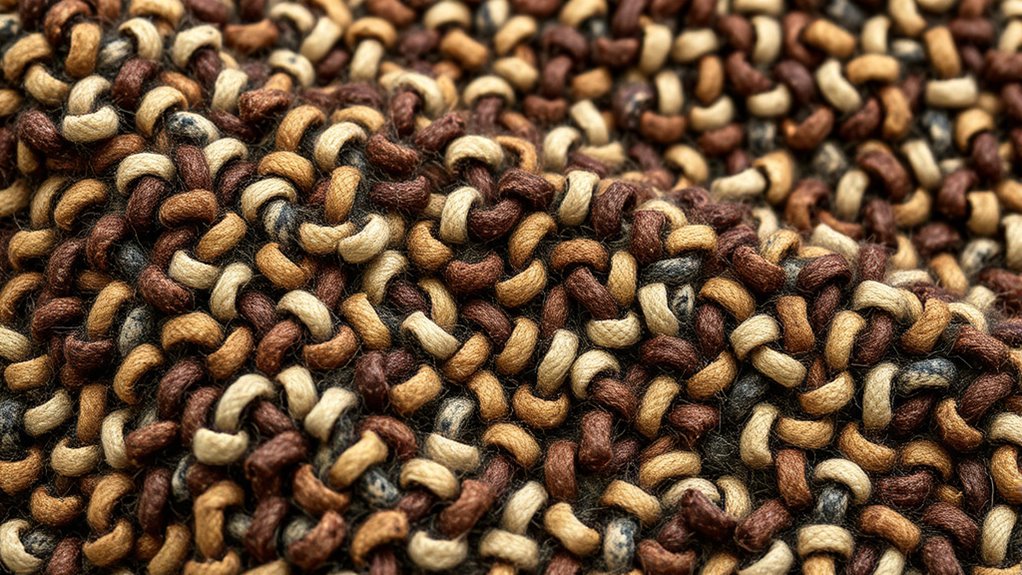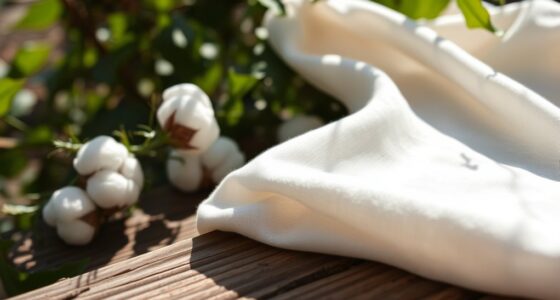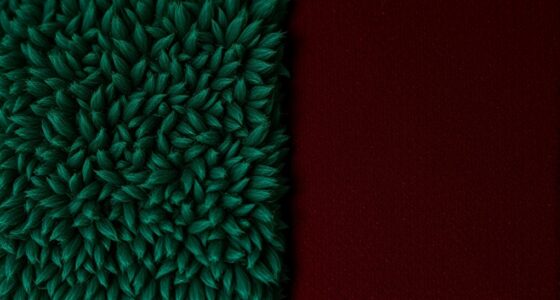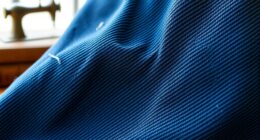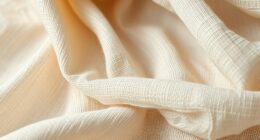Bouclé and tweed are classic textured fabrics with rich histories rooted in traditional crafts from France, Scotland, and Belgium. Bouclé features a looped, knotted surface that adds a soft, distinctive texture, while tweed is known for its rough, durable weave made from woolen yarns. Both fabrics have an uneven, natural appearance that gives garments depth, character, and warmth. If you keep exploring, you’ll discover how these unique textures can elevate your next project.
Key Takeaways
- Bouclé features a looped, textured surface with a rich history rooted in French craftsmanship, while tweed is a durable, rough-textured fabric originating from Scotland.
- Both fabrics have natural, uneven structures that add depth and visual interest to garments and accessories.
- Working with these textiles requires careful handling, sharp tools, and gentle sewing techniques to preserve their texture.
- Cutting and pressing should be done with precision and care to maintain the fabric’s character and avoid damage.
- Their timeless appeal makes them ideal for sophisticated, warm garments emphasizing texture, craftsmanship, and personality.
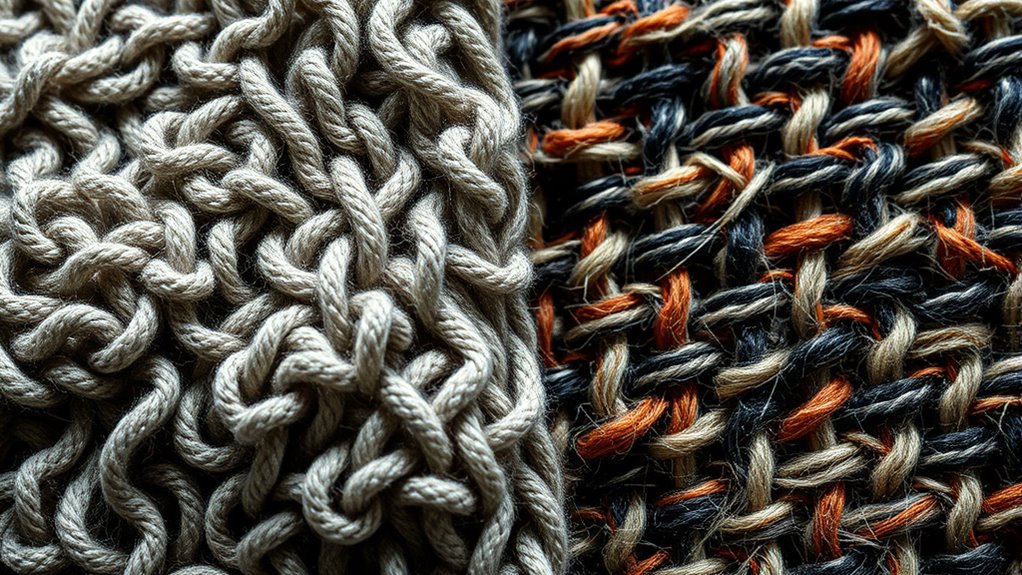
Have you ever wondered what makes certain fabrics stand out with their unique appeal? Textured fabrics like bouclé and tweed have a rich history that adds depth and character to their visual and tactile qualities. The history of textured fabrics dates back centuries, with origins rooted in traditional craft techniques from regions like France, Scotland, and Belgium. Bouclé, meaning ‘curled’ or ‘ringed’ in French, emerged in the early 20th century, becoming popular for its looped, knotted surface that creates a distinctive look and feel. Tweed, on the other hand, has its roots in the Scottish Highlands, originally crafted from rough, woolen yarns to withstand harsh weather conditions. Over time, both fabrics became symbols of sophistication and craftsmanship, evolving from utilitarian textiles to high-fashion staples. Their enduring appeal lies not just in their history but in the techniques used to create their textured surfaces.
Working with textured fabrics requires specific techniques to capture their full potential. Since bouclé and tweed have uneven surfaces, you need to handle them carefully to avoid damaging the fibers or distorting their structure. When sewing with bouclé, use sharp needles and pins to prevent snagging or pulling on the loops. It’s best to sew slowly and avoid pulling the fabric through the machine too forcefully. Basting stitches can help keep layers aligned, especially when working with complex patterns or seams. With tweed, you should consider interfacing or lining to smooth out the bulk and give your finished piece a polished look. Cutting tweed requires precision—use very sharp scissors to prevent fraying and cut with the fabric’s weave in mind to maintain pattern alignment. Both fabrics respond well to pressing, but be cautious with heat settings, as high temperatures can damage the fibers or flatten the texture.
The key to working successfully with bouclé and tweed lies in patience and attention to detail. These fabrics often have a natural, somewhat irregular structure, which can be a challenge if you’re accustomed to smooth textiles. However, their textured nature adds visual interest and depth that can’t be easily replicated with plain fabrics. When selecting patterns, opt for simple designs to let the fabric’s character shine through. Also, reinforce seams and edges, because textured fabrics tend to fray more easily. With proper techniques, you can create stunning garments or accessories that showcase the timeless charm of bouclé and tweed. Their history and craftsmanship make them ideal choices for adding sophistication, warmth, and personality to any project, so embrace their quirks and enjoy the process of working with these remarkable textiles.
Frequently Asked Questions
How Do I Care for Bouclé and Tweed Fabrics?
To care for bouclé and tweed fabrics, you should follow dry cleaning tips to keep them looking their best. Avoid machine washing, as it can damage the texture. Instead, opt for professional dry cleaning, especially for delicate or heavily soiled pieces. Store these fabrics properly by hanging them in a cool, dry place, using breathable garment bags to prevent dust and moth damage. Regular gentle brushing also helps maintain their texture and appearance.
Are Bouclé and Tweed Suitable for All Seasons?
Imagine a cozy fireplace that warms your home in winter but can be opened to welcome fresh air in summer. Bouclé and tweed offer seasonal versatility, but their fabric weight considerations matter. Light tweeds work well in spring and autumn, while heavier bouclé keeps you warm in winter. However, they might feel too warm for hot summer days, so choose your fabric weight based on the season to stay comfortable year-round.
Can Bouclé and Tweed Fabrics Be Machine-Washed?
You can’t typically machine-wash bouclé and tweed fabrics, as they require dry cleaning considerations to prevent damage. If you get a stain, try gentle stain removal tips like blotting rather than rubbing, and always check the care label first. Hand washing is usually risky, so it’s best to leave cleaning to professionals to maintain their texture and durability. Regular dry cleaning keeps your fabrics looking their best.
What Are the Best Matching Accessories for These Fabrics?
For bouclé and tweed fabrics, you should choose accessories that enhance their textured appeal. Opt for simple, elegant pieces like leather handbags or minimal jewelry to avoid overwhelming the fabric’s richness. Focus on accessory pairing with neutral or complementary colors to achieve seamless color coordination. Classic scarves, understated earrings, or structured shoes work well, ensuring your accessories highlight the fabric’s texture without competing for attention.
Are There Eco-Friendly Options for Bouclé and Tweed Textiles?
Like a gust of fresh air, yes, you can find eco-friendly options for bouclé and tweed textiles. You should look for fabrics made from sustainable sourcing, such as organic wool or recycled fibers, which reduce environmental impact. Additionally, seek out eco-friendly dyes that minimize chemical use. These choices help you enjoy textured fabrics while supporting eco-conscious practices, making your style both stylish and sustainable.
Conclusion
By now, you see how bouclé and tweed bring unique textures and character to your wardrobe. Imagine choosing a tailored tweed blazer for a professional look—its rich, tactile surface adds depth while making a subtle statement. Just like a fashionista who transformed her style with a classic bouclé jacket, you can embrace these fabrics to elevate your outfits. Incorporate textured fabrics, and watch your fashion sense become more sophisticated and inviting.
